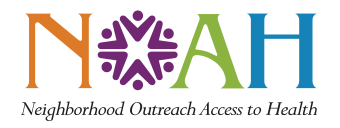What is Play Therapy?
Play therapy provides a unique opportunity for patients of all ages to connect with counselors by sharing their thoughts and feelings through activities.
NOAH is excited to announce the opening of play therapy rooms at Cholla Health Center in Scottsdale and Copperwood II Health Center in Glendale. Both spaces along with specialized training for NOAH counselors were funded through a generous grant from the Ibis Foundation of Arizona. Features of the play therapy rooms include:
Play
- Play is the primary form of learning in small children.
- Difficult and stressful things can be acted out through play.
- Having a conversation through a toy telephone or showing home life through a doll house and characters can help a child talk about a hard thing.
- Toys like a pounding bench, bean bags, and punching bags help teach and practice self-regulation skills.
Art
- There are many things words can’t describe. Painting, drawing, and other forms of art give patients ways to express their emotions nonverbally.
- Patients may be asked to create art following a single prompt, a series of instructions, or no direction at all.
Emotion
- It can be difficult to talk about emotions when you don’t know the names or definitions for most of them.
- In play therapy counselors use tools to help patients understand emotions and describe their feelings.
- In an emotion exercise, a patient may catch a ball labeled with common emotions and where their thumb lands, tell the counselor about the last time they felt that way.
Building
- Building activities encourage play that copies real-life situations.
- Whether with Legos, Tinker Toys, or blocks, the act of building can improve self-confidence or develop skills like problem-solving.
- Building in therapy can be a non-stressful activity where the counselor follows the child’s lead while they build anything or it can be therapist led to recreate a specific stressful event.
Games
- Games are a multifunctional activity, and most of the time, they are just fun. However, the therapist can select a game that will help practice a learned skill, define a concept, mimic a situation, or encourage mindful or even mindless conversation.
- Games like Mancala or Jenga are designed to be stressful and raise anxiety responses, allowing patients to practice anxiety management skills.
- Other games like Left, Right, Center, or Sorry challenge the idea that needs-based interactions are selfish and help children see the difference between being mean and fulfilling individual needs.
- Uno, Trash, and Don’t Break the Ice allow the brain to rest and be distracted while talking and In a Pickle or Suspend help with family communication.
Reading
- Reading is a social-emotional activity that allows for increased connection and communication.
- Therapists use books of all kinds for all ages. The book “Through the Gate” shows a child’s move to a new home. The story sparks conversation about change and even growing up.
- Reading also allows the therapist to help parents learn how to listen.
- It can be as simple as teaching parents how to read to, and with, their children or as complex as how to read books to children that address hard-to-manage issues, like “The Invisible Leash” which addresses the death of a pet.
Play therapy is a clinical form of behavioral health treatment that may be recommended by your NOAH provider. If you or someone you know may benefit from play therapy or other methods of behavioral health treatment, request an appointment online or call 480-882-4545 to schedule an evaluation.

